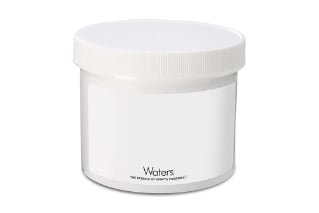
|
Separation Mode |
Reversed Phase |
|
Detection Method |
UV |
|
Formulation |
Liquid |
|
Storage Condition |
Room Temperature |
|
System Type |
LC |
|
Shipping Condition |
Ambient |
|
Volume |
20 mL |
|
Type |
Reagent |
|
UNSPSC |
41116105 |
|
Product Type |
Reagents |
|
Units per Package |
5 pk |
PIC B5 Low UV Reagent
Paired-Ion Chromatography (PIC® Reagents) is a simple method for evaluating ionic species in materials. These reagents enable the separation of ionic substances using reverse-phase chromatography, reducing time by allowing the simultaneous assay of acids, bases, amphoteric, and neutral chemicals.
Waters PIC® Reagents enable the separation of ionic substances by reversed-phase chromatography while removing the issues associated with ion exchange, such as precise pH and temperature control, repeatability, and short column life. Waters PIC Reagents are purified and quality controlled by liquid chromatography to provide consistent results, are preformulated for convenience of use and are buffered to an acceptable pH for most acidic and basic chemicals.
PIC B can be used to separate bases quickly. Another class of substances that is typically separated by ion-exchange chromatography can be separated more easily by paired-ion chromatography using one of the PIC Reagent B series.
PIC B5 Low UV is a pentane sulfonic acid 5 vial/pkg with a usable UV range in mobile phase 200+ nm. Low UV PIC is specially formulated to eliminate background interference in the low UV range and offers method development opportunities for ion pairs that do not have a chromophore in the working range of regular PIC Reagents, increased sensitivity for compounds normally used with existing PIC Reagents, and the potential for selectivity changes due to alternative buffers when compared to regular PIC Reagents.
Explore our website and catalog to learn more about variations of different PIC Reagents or to locate different pieces of lab equipment that are compatible with it, or even shop for lab equipment to replace your stock and add to your existing equipment portfolio.
You might also be interested in the IonHance Difluoroacetic Acid Mobile Phase Kit, which comprises two 1.1 mL IonHance DFA vials and two 1000 mL LDPE mobile phase bottles to maintain IonHance's high levels of purity. To generate extraordinarily high-quality mass spectra, both the PFA and LDPE (low-density polyethylene) containers are carefully QC-checked to ensure less than 100 ppb amounts of salt and potassium.
How Does Enrichment in Low Concentration Sample Components Happen?
Several steps can be taken to enrich sample components that are present in low amounts. To selectively elute analytes, you can change the gradient stages. Another useful method is to employ "large" sample volumes in an adsorption-promoting solvent. In a desorption-promoting solvent, use a "small" collection volume. Use analyte-specific sorbent chemistry that is separate from the sorbent chemistry utilized in the analytical column. The chemistry of the solid-phase extraction column should be carefully chosen to eliminate the need for additional sample preparation.